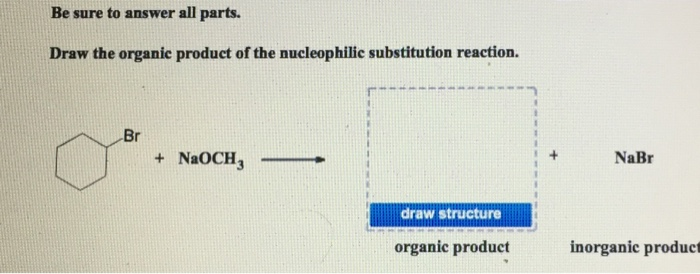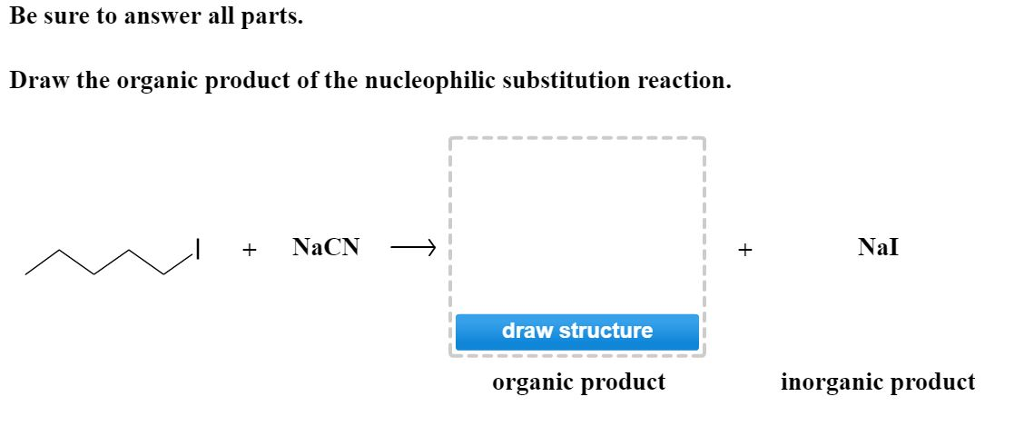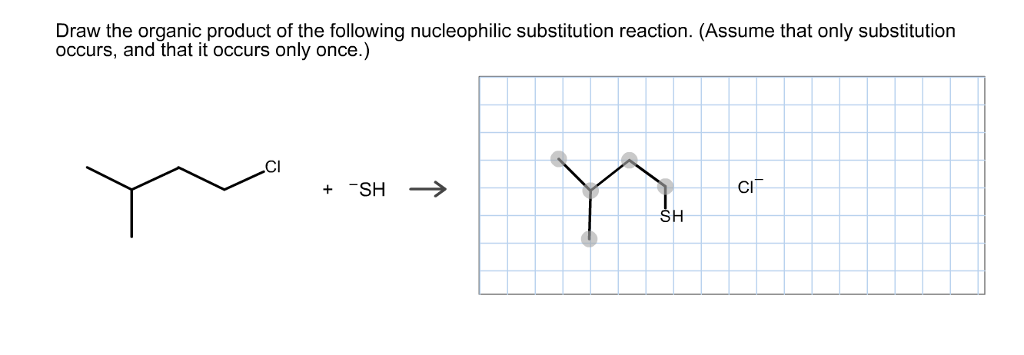Substitution of alkyl halides with thiolates to form thioethers also known as sulfides. First a strong base deprotonates the thiol we use NaH here but many other bases could also be used.

Draw The Organic Product Of The Following Nucleophilic Substitution Reaction Assume That Only Substitution Occurs And Homeworklib
I Write an equation for this reaction.

. The cyanide ion attacks at the partially positive carbon of the dipole making a high energy transition state. The most common reaction of ethers is. Because after the initial nucleophilic attack the oxygen with the hydrogen can be quickly neutralized by removal of a proton whereas the other oxygen cannot go back to being a neutral species without breaking C-O or O-O.
Heres a textbook example of the sulfur analogue of this reaction. As phenols do not undergo nucleophilic substitution reactions even if an excess of HX is used the products from the cleavage of an aryl alkyl ether are a phenol and an alkyl halide. Draw a mechanism for the cyclohexene synthesis reaction described above.
The difference with aldehydes and ketones is that the product of this addition reaction to the carbonyl contains an alkoxy group on the tetrahedral intermediate. Try and draw out. Propene is not the only product of this reaction.
3 2 1 Methyl 63 actorsF A ecting the Rates of S N1 and S N2 Reactions. Also draw a mechanism showing how the undesired cyclohexyl phosphate could form. 62 Carbocation Stability Order of Carbocation Stability.
In the first step we have the nucleophilic attack of the Grignard making the C-C bond and shifting the electrons of the π bond to the oxygen. 61 General Nucleophilic Substitution Reactions A deprotonation step is required to complete the reaction when the nucelophile was a neutral atom that bore a proton Example showing deprotonation 4. Secondly we add an alkyl halide and an S N 2 reaction results.
Further substitution can occur during this reaction. Ethers are known to be unreactive towards most reagents which makes them excellent reaction solvents. Mechanisms of nucleophilic substitution.
Identify the main organic product when a large excess of chlorine is used in this reaction. This process resembles the Williamson to a tee. This group is a relatively good leaving.
3 Page 10 of 35 b Ethanenitrile can be made by reacting chloromethane with potassium cyanide. The bromine atom leaves with its bonding electrons as a bromide ion. Diaryl ethers are not cleaved by acids.
Nucleophilic substitution with cyanide ions. The final product is a nitrile. Draw the structure of this compound.
Next lets put aside the issue of competition between nucleophilic substitution and elimination and focus on the regioselectivity of.

Draw The Organic Product Of The Following Nucleophilic Substitution Reaction Include The Appropriate Hydrogen Atoms In Homeworklib

Solved Be Sure To Answer All Parts Draw The Organic Product Chegg Com

Draw The Organic Product Of The Following Nucleophilic Substitution Reaction Include All Hydrogens Atoms Homeworklib

Draw The Organic Product Of The Nucleophilic Substitution Reaction Study Com

Solved Draw The Organic Product Of The Nucleophilic Chegg Com

Solved Be Sure To Answer All Parts Draw The Organie Product Chegg Com


0 comments
Post a Comment